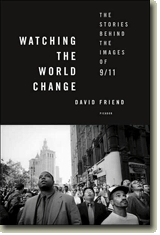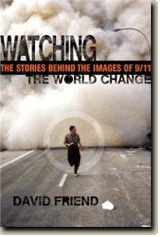March 2008 Archives
« Previous · Home · Next »
March 30, 2008
BEHIND THE CAMERA AT ABU GHRAIB
The advance buzz for Errol Morris’s new Abu Ghraib documentary, Standard Operating Procedure – set for release in late April - is already deafening. For a glimpse of the movie trailer, CLICK HERE.

But for those looking for powerful, distilled high-octane Morris, right this instant, please check out the revelatory piece by Morris and Philip Gourevitch in the March 24 issue of The New Yorker. The article, “Exposure,” timed to fan the flames for Morris’s film (and adapted from the forthcoming book, Standard Operating Procedure) centers on the story Sabrina Harman, the American reservist who took some of the most memorably incendiary images at Iraq's Abu Ghraib prison.
Harman, who joined the reserves with hopes of some day becoming a police department forensic photographer, shot hundreds of images of systematic atrocities at Abu Ghraib. She claims the photos were her way of chronicling the horrors she witnessed – evidence which she then hoped to pass along to the press upon her return to the States. “I was trying to expose what was being allowed,” she is quoted as saying, “what the military was allowing.”
Write Gourevitch and Morris, “In other words, she wanted to expose a policy; and by assuming the role of a documentarian she had found a way to ride out her time at Abu Ghraib without having to regard herself as an instrument of that policy. But it was not merely her choice to be a witness to the dirty work on Tier 1A [the so-called Hard Site at Abu Ghraib, where detainees were routinely tortured]: it was her role. As a woman, she was not expected to wrestle prisoners into stress positions or otherwise overpower them but, rather, just by her presence, to amplify their sense of powerlessness. She was there as an instrument of humiliation.”
Harman, through photographs and letters home, was able to isolate the actions of her fellow soldiers and somehow deflect or absolve herself of her own complicity. “Harman,” they write, “seemed to conceive of memory as an external storage device. By downloading her impressions to a document, she could clear them from her mind and transform reality into an artifact. After all, she said, that was how she experienced the things she did and saw done on prisoners on Tier 1A: ‘It seems like stuff like this only happened on TV…. It’s just something that you watch and that is not real.’ ”
Harman was famously photographed in the Al Hillah morgue, leaning over the corpse of an Iraqi detainee while giving a “thumbs-up” sign. As Morris and Gourevitch point out, “There are at least twenty photos from [the village of] Al Hillah in which she is in the identical pose, same smile, same thumbs-up….[This is the posture] she usually [assumed] when a camera was pointed at her. [Said Harman,] ‘I kind of picked up the thumbs-up from the kids in Al Hillah.” Harman also photographed the shot of the lone hooded figure, mock electrodes attached to his fingers, as he was made to stand on a crate. The picture, a facsimile of which Harman later tattooed onto her arm, has become perhaps the iconic image of the ill-fated war in Iraq. (For a discussion of this photo, see pages 303-307 and 401-402 of Watching the World Change.)
In their New Yorker story, Gourevitch and Morris note that the photograph “achieves its power from the fact that it…creates…an original image of inhumanity that admits no immediately self-evident reading. Its fascination resides, in large part, in its mystery and inscrutability – in all that is concealed by all that it reveals. It is an image of carnival weirdness…. The pose is obviously contrived and theatrical, a deliberate invention that appears to belong to some dark ritual, a primal scene of martyrdom. The picture transfixes us because it looks like the truth, but, looking at it, we can only imagine what that truth is: torture, execution, a scene staged for the camera?
“Had there been cameras at Calvary,” the authors ask, “would twenty centuries of believers have been moved to hang photographs of the scene on their altarpieces and in their homes?”
ALSO WORTH READING THIS WEEK:
ERROL MORRIS UNVEILED… I’m impressed with the new book, Non-Fiction, out next week from photographer Nubar Alexanian, in which he documents his friend Morris on the set and off.
PREDATOR PIX… According to Mark Hosenball and his colleagues at Newsweek (March 31, 2008) “The United States has stepped up its use of pilotless [and oftimes camera-equipped] planes to strike at Qaeda targets along Pakistan’s rugged border area…. Since January, missiles reportedly fired from CIA-operated Predator drones have hit at least three suspected hideouts of Islamic militants.” (See pages 106 and 175 of Watching the World Change for Hosenball’s 9/11-related assessments.)
POLLS ON A 9/11 PLOT... In today’s New York Times, columnist Nicholas Kristof reminds us that a recent poll from Ohio University “found that 36 percent of Americans believed that federal officials assisted in the attacks on the twin towers or knowingly let them happen so that the U.S. could go to war in the Middle East.” More than a third of the country still clings to this myth, promulgated by the so-called 9/11 Truth Movement, five and six years after the attacks.
THE NEW PAPARAZZI… For all the criticism The Atlantic Monthly received this month for running a cover story on Britney Spears and the 21st century ascension of the new paparazzi, the magazine succeeds with its April Issue article “Shooting Britney,” which makes great reading for anyone interested in the state of play in the celebrity-ambush business. Photographer Francois Navarre (nicknamed Dano), owner of the X17 paparazzi agency, reveals how he hires posses of immigrant teens, provides them with digital cameras, and has them stalk stars for between $800 and $3,000 a week – in return for granting his agency all the rights to their snaps. “X17 also pays weekly stipends,” writes David Samuels, “to a dozen dedicated tipsters and occasional fees to 500 or 600 parking-lot attendants, club kids, and shop girls in and around L.A.”
How’s this for inside-baseball? According to Samuels, “Paparazzi prefer to work in a triangle, with the celebrity at the center and the shooter on three sides. That way, when they turn away from one camera, they are facing another, and when they turn away again, they are facing a third shooter. As Dano retreated from [Britney Spears, as she tried to attack the pack with an umbrella], two flanking X17 photographers took stills while Dano shot video…. Stills and videos of the incident sold for nearly $400,000.”
(For a withering satire of the paparazzi pack mentality, view this video, courtesy of MySpace TV.)
March 19, 2008
RECOMMENDED LINKS
The Smithsonian Institution has just launched an online exhibition and interactive photo project-database-"Webinar," curated by scholar Marvin Heiferman, called "Click! Photography Changes Everything." Yours truly has a piece up on the Website (adapted from Watching the World Change) about the importance of Wolfgang Staehle's photographic sequence taken on the morning of September 11. Please take a look. The site will grow each week as the Smithsonian adds more offerings.

PHOTO BY WOLFGANG STAEHLE
Also... On the VF DAILY Blog this week, at VanityFair.com, I discuss the new book L'Irak N'Exist Plus by Regis Le Sommier, the New York correspondent for Paris Match, who has reported extensively on 9/11, its aftermath, and the war in Iraq.
March 16, 2008
IMAGES AS EVIDENCE
AUSCHWITZ ALBUM
I heartily recommend Alec Wilkinson’s mesmerizing essay in this week’s New Yorker, “Picturing Auschwitz," on the power of a recently discovered photo album which, for the first time, shows the quotidian lives of Nazis who operated the killing machine at the Auschwitz death camp. Like the watershed Lodz Ghetto Album (showing "ghetto photographer" Henryk Ross’s previously unseen pictures of privileged Jews who were spared execution by agreeing to collaborate with their Nazi-aligned superiors), the Auschwitz photo trove constitutes the only known visual evidence of the perpetrators’ everyday existence.
Had the Auschwitz photographs not been taken, stowed away, retrieved, and explained by archivists, these details would have surely been lost forever. And we would have had less direct knowledge of the banality of evil.

The New Yorker provides an expanded album of images on its Web site, including the above group shot of Auschwitz officers singing at a retreat in 1944, with Dr. Josef Mengele plainly visible in the front row, third from right, facing the accordianist. (Mengele, who conducted hideous mock-scientific experiments on twins and others, was called the camp’s Angel of Death because he would often stand at Auschwitz-Birkenau’s boxcar receiving ramp and decide which arriving prisoners would live and which would go immediately to the crematoria.)
PENTAGON TAPES
The Pentagon this week admitted that it had unearthed at least 50 videotapes of post-9/11 interrogations of prisoners at its facilities across the globe. While these are not the infamous C.I.A. torture tapes, destroyed by the agency against the advice of Justice Department lawyers, they do raise the intriguing notion that even more incriminating footage may be unearthed in the near future.
In my December 15 blog post, “Watergate vs. Waterboard,” I noted:
“My guess is that we haven’t seen the end of the torture tapes. Somewhere, in some safety deposit box or closet or attic, or deep in the recesses of a rogue hard drive, someone – an underling, a supervisor, or an agent (whether proud of his actions, enraged by the actions of a colleague, or hoping to cover his ass) - made a dupe that he’s been squirreling away for three or four years, a copy of which will inevitably find its way into Congressional hands (or wind its way up onto YouTube), making dupes of everyone involved.
“Patience, patience. In this age when data is forever-stored and passed along, like traces of DNA in a genome, it wouldn't surprise me if somehow someone somewhere will unload that damning cache. “
MISCELLANY...Renowned sports columnist George Vecsey, in today’s New York Times, writes about a snapshot of Yankee pitcher Roger Clemens and a fan – 24-year-old Kevin Williams, who had worked for Sandler O’Neill on the 104th floor of the World Trade Center.

...And, finally, on a wholly unrelated and lighter note, please check out my blog post at VanityFair.com - about the Eliot Spitzer mess: "A Governor's Glossary."
March 9, 2008
THIS WEEK'S IRIS SCAN
“There are too many images,” he said. “Too many cameras now. We’re all being watched. It gets sillier and sillier. As if all action is meaningful. Nothing is really all that special. It’s just life. If all moments are recorded, then nothing is beautiful and maybe photography isn’t an art anymore. Maybe it never was.”
--Photographer Robert Frank, to writer Charlie LeDuff, in the new issue of Vanity Fair (in an article on the 83-year-old Frank's visit to China to celebrate the 50th anniversary of the publication of his seminal book, The Americans).
...Jim Dwyer (co-author of 102 Minutes, the compelling best-seller about what went on inside the twin towers on September 11) writes in the Times this weekend about a subject explored in depth in Watching the World Change: the shortcomings of "biometric" data-mining and the inability of visual-surveillance technologies to isolate the facial characteristics of potential terrorists. Definitely worth your iris scan.
...Last fall, Shelby Monroe, a librarian at the Chappaqua Public Library, attended a talk I gave there for Watching the World Change. At the time, she asked my advice about potential publishing partners for a blog she was going to be posting – from Iraq, where she was volunteering as an embedded “observer,” a citizen journalist. The suburban section of the Times profiles her in this weekend’s edition.

…You might want to check out this column in the Vancouver Sun on the pernicious persistence of viral Internet rumors, which includes this hokey photo sent across the Web in the days after 9/11.

…For comic relief, read this inventive satire from Yankee Potroast on overly obsessive HTML-taggers.
…Meanwhile, yours truly was on ABC’s 20/20, promoting this article from the new issue of Vanity Fair: “A Claim on Camelot,” about a man who has reason to believe he may be the secret illegitimate son of John F. Kennedy. I hope you’ll agree that the story is quite a yarn.

…And, while we're at it, here’s my VanityFair.com "morning-after" blog post (from last Wednesday, when Hillary Clinton posted 3 of 4 key primary victories) about how TV news programs, instead of delivering the who-what-where-when-how, now have a tendency to gin up conflicts so as to create compelling soap-opera-style narratives. (“In an era when entertainment companies control the airwaves, television news is often a series of zippy, zealous narratives, overtold and oversold, like faux ‘reality shows’ in which false hurdles are erected for the purpose of creating nightly, photogenic winners and losers, with one contestant plucked from the running, for our viewing pleasure.”)
At times I find myself pining for the days of “Just the Facts, Ma’am.”
…And since we’re on the topic, why not click over to this essay by the Washington Post’s Peter Carlson on the deadlocked Democratic convention of 1924, which went 103 – count ‘em! – ballots, before a nominee was named.
(I notice that Carlson talks about how “TV yappers…jibber-jabber.” In my blog post I describe how we “watch pundits go at each other in swashbuckling gibber-matches.” Which is it? Jibber, as in jib-jab...or gibber, as in gibberish?)
March 2, 2008
3 GIRLS WATCHING, 2001
At a talk about Watching the World Change last month at the Reform Club in London, I met photographer George Torode, who sent me the following, previously unpublished image to share.

PHOTO BY GEORGE TORODE
Wrote George: “I am a freelance photographer who was in New York on 9/11 and took a series of photographs... The attached images focused on the human response in Brooklyn. I shot 35mm slide and cross processed it as neg to produce ‘alien’ high contrast and saturation images. Processed this way they highlight the viewer's difficulty to engage rationally with an event so enormous it appears otherworldly, surreal and detached."
Meanwhile…. I highly recommend 5b4, a blog about photography, design and books.
And... if you’re in the mood, see “A Claim on Camelot,” an article I’ve written for the forthcoming issue of Vanity Fair. It was posted late Friday on VanityFair.com.
Finally, now that baseball’s spring training has commenced and Hope Springs Eternal, see this blog post by yours truly on Hillary (Cubs Fan) vs. Obama (White Sox Fan).


